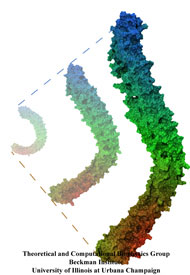Research Topics - Steered/Interactive Molecular Dynamics
Knowledge of the mechanism of association, dissociation and unfolding of macromolecules is important for many biological processes. Among the examples are the binding and dissociation of substrates of enzyme reactions, the recognition of ligands by their receptors or the elastic resopnse of mechanical proteins. In order to study such processes external forces can be applied reducing energy barriers and therefore increasing the probability of unlikely events on the time scale of molecular dynamics. This approach has the advantage that it corresponds closely to micromanipulation through atomic force microscopy or optical tweezers. The external force techniques can be applied to study many processes, including dissociation of avidin-biotin complex, dissociation of retinal from bacteriorhodopsin, stretching of titin, etc. The molecular dynamics program NAMD, developed in the group, is capable of performing several different kinds of SMD, including rotation or translation of one or more atoms. The group's molecular graphics program VMD provides a powerful means of visualizing these simulations, and through the Interactive Molecular Dynamics (IMD) interface can even allow SMD simulations to be performed in real time.

image size:
91.7KB
movie (
789.9KB
)
Mechanical forces are everywhere in human life. Strong forces power machines and cars, our body's forces let us labor and move, soft forces are sensed through touch, even softer ones through hearing. Forces are also ubiquitous in the living cell, driving its molecular machines and motors as well as signaling ongoing action in its surroundings. Man made, force bearing machines rely on extremely strong materials not found in the cell. How can the cell bear substantial forces? Also, how do cells sense extremely weak forces as in hearing, surpassing most microphones? Single molecule measurements begin to answer these questions offering information on biomolecules' mechanical responses and action. However, the information offered by these measurements is not enough to relate the biomolecular function to the biomolecular architecture. Biomolecules in cells can move in amazing ways, but we did not know why. As a review in Science demonstrates, computational modeling comes to the rescue. It can simulate the measurements and, in doing so, can reveal the physical mechanisms underlying cellular mechanics at the atomic level. In as far as observed data are available, the simulations show impressive agreement with actual measurements. While initially only following experiments or, at best, guiding experiments, modeling has advanced now further and through simulated measurements discovered on its own entirely novel mechanical properties that were later verified by experimental measurements. Experimentalists reacted to the new competition and began to do simulations themselves.
Papers
Onset of anthrax toxin pore formation. Mu Gao and Klaus Schulten. Biophysical Journal, 90:3267-3279, 2006.
What makes an aquaporin a glycerol channel: A comparative study of AqpZ and GlpF. Yi Wang, Klaus Schulten, and Emad Tajkhorshid. Structure, 13:1107-1118, 2005.
In search of the hair-cell gating spring: Elastic properties of ankyrin and cadherin repeats. Marcos Sotomayor, David P. Corey, and Klaus Schulten. Structure, 13:669-682, 2005.
Calculating potentials of mean force from steered molecular dynamics simulations. Sanghyun Park and Klaus Schulten. Journal of Chemical Physics, 120:5946-5961, 2004.
Insights into the molecular mechanism of rotation in the Fo sector of ATP synthase. Aleksij Aksimentiev, Ilya A. Balabin, Robert H. Fillingame, and Klaus Schulten. Biophysical Journal, 86:1332-1344, 2004.
Mechanisms of selectivity in channels and enzymes studied with interactive molecular dynamics. Paul Grayson, Emad Tajkhorshid, and Klaus Schulten. Biophysical Journal, 85:36-48, 2003.
Identifying unfolding intermediates of FN-III10 by steered molecular dynamics. Mu Gao, David Craig, Viola Vogel, and Klaus Schulten. Journal of Molecular Biology, 323:939-950, 2002.
Structural determinants of MscL gating studied by molecular dynamics simulations. Justin Gullingsrud, Dorina Kosztin, and Klaus Schulten. Biophysical Journal, 80:2074-2081, 2001.
Unfolding of titin immunoglobulin domains by steered molecular dynamics simulation. Hui Lu, Barry Isralewitz, André Krammer, Viola Vogel, and Klaus Schulten. Biophysical Journal, 75:662-671, 1998.
Molecular dynamics study of unbinding of the avidin-biotin complex. Sergei Izrailev, Sergey Stepaniants, Manel Balsera, Yoshi Oono, and Klaus Schulten. Biophysical Journal, 72:1568-1581, 1997.
Research Projects
- Mechanical Strength of the Titin/Telethonin Complex
- IMD and the Glycerol Channel
- Unbinding of Retinoic Acid from its Receptor
- Retinal's Binding Pathway in bR
- Unbinding of the Avidin-Biotin Complex
- Molecular Basis for Anthrax Intoxication
- Molecular Motor Scooting along DNA
- Lactose permease
- Bacteria Swim and Tumble
- Hook and Sensor of Cells
- Computational Force Microscopy
- Detecting DNA Orientation with a Nanopore



